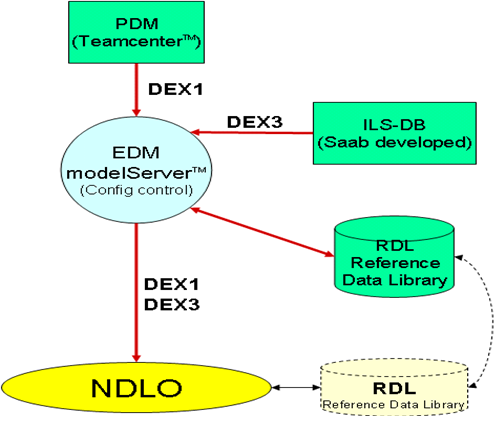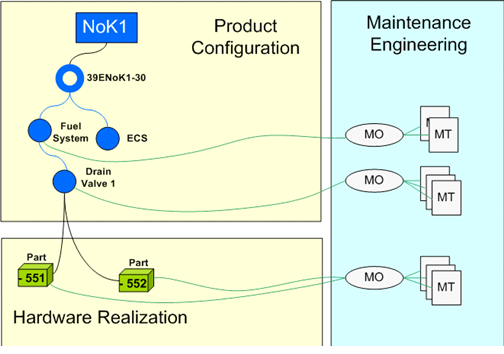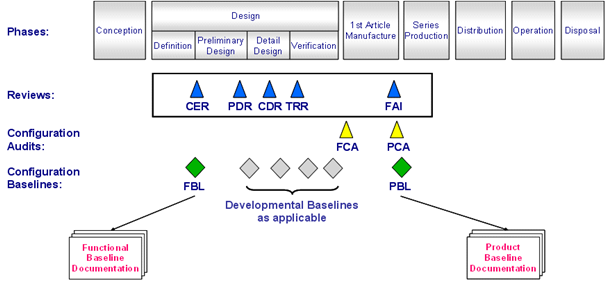
| Business DEX (NOLITO001):— Gripen_product_breakdown | Date: 2008/12/07 15:20:14 Revision: 1.21 |
This Business DEX enables the exchange of information about the Gripen aircraft product breakdown (structure) for the purpose of supporting the Gripen aircraft throughout life. It is a subset of the OASIS DEX product_breakdown_for_support, adapted for the needs of the NOLITO project.
The DEXs in the NOLITO business concept are intended to describe the user requirements and the system requirements for the NOLITO solution.
The NOLITO solution integrates several existing software applications at Saab using the EDMmodelServer™ for PLCS. The entire system will be used to:
The main objective of the system is to support Saab in their efforts to integrate product information that today is spread over several software applications. A related and likewise important objective is to enable Saab to deliver data for the Gripen support solution in PLCS format to the NDLO. Figure 1 illustrates the scenario for these objectives and for the requirements stated in this document.

The project shall utilize results from international standardization (OASIS) as regards the DEXs as interfacing formats and PLCS as exchange model. In addition the project will utilize international standards (ISO 12006, ISO 15926) in order to design and establish the RDL platform.
The project shall:
The NOLITO solution will be used at Saab in their environment for the Gripen aircraft design. The solution derived from these user and system requirements will be a prototype; further development and adaptations may be needed for application in the production at Saab.
The NOLITO solution will run on its own machine, a PC with a Windows™ operating system. This PC will be connected into the local area network at Saab.
The NOLITO solution adds software components to the existing design production environment at Saab. It will not replace existing functionality, but will enable applications to export information required to build an overall integrated product model and in accordance to predefined workflow processes. This exchange and consolidation of information eliminates data inconsistencies and increases the quality of the application data.
The design production environment uses the systems in the following Table that shall be interfaced to the NOLITO solution.
|
ID |
Type |
Brand name |
Role at Saab |
Role for NOLITO |
|---|---|---|---|---|
| 1 | PDM | Teamcenter Enterprise™ | holds the product structure and configuration; controls the workflow of production | Creates information to be exported to EDMmodelServer™ for PLCS |
| 2 | PDM PLCS export | Teamcenter Enterprise™ STEP export processor | translates PDM data to the PLCS standard representation | to be developed |
| 3 | ILS-DB | Saab in-house development | integrated logistics support; Maintenance requirements, tasks, and resources. | Creates information to be exported to EDMmodelServer™ for PLCS and integrated with the Teamcenter™ information |
| 4 | ILS-DB PLCS export | ILS-DB STEP export processor | translates ILS data to the PLCS standard representation | to be developed |
| 5 | Integrated PLCS DBMS | EDMmodelServer™ for PLCS | data exchange and integration incl. workflow control | to be configured; functionality to be added |
Table — Systems at Saab that are part of the NOLITO solution
Today Saab applies a dedicated software application for notification management: Saabs' Integration Platform (SIP). This application should also manage all notifications for the NOLITO solution, that is, notifications among Teamcenter™, ILS-DB and EDM. Such an extension to the SIP would, however, exceed the project scope.
Therefore, NOLITO shall simulate the SIP functionality of sending messages among the NOLITO applications by existing EDM functionality.
The basis for the NOLITO requirements is the use cases that are described in the following sections. They are at the same time test cases for the system tests and are the scenario for the final demonstration.
The support objects that these use cases focus on are displayed in Figure 2, below.

The yellow areas in Figure 2 are managed by Teamcenter™ (TC), the blue one by ILS-DB. Configuration items are functions or physical parts that need a support solution; therefore, they shall be linked to maintenance objects. This link, however, does neither exist in Teamcenter™ nor in ILS-DB; it shall be established during the PLCS integration and before delivery to the NDLO.
It also happens that the scope of the two DEXs in the NOLITO project have a similar scope as the internal systems at Saab. The Scope of Business DEX NOLITO001 Gripen Product Breakdown for Support is the yellow area in Figure 2, and corresponds to the information stored in the Teamcenter™ database. The blue area in the figure corresponds to the scope of Business DEX NOLITO003 Task Set, as well as ILS-DB information.
Both Teamcenter™ and ILS-DB enable the creation of baselines, that is, collections of versions of items that together represent a meaningful whole. With the approval of a baseline a development task is completed and its result is ready for being communicated to others. Thus, baselines play an important role in the following use cases as they are central integration concepts. Teamcenter™ baselines are called product configuration baselines, whereas ILS-DB baselines are maintenance baselines.
The use cases are derived from the following needs:
The NOLITO project has defined 5 use cases:
For Business DEX NOLITO001 Gripen Product Breakdown for Support, use cases 1, 3 and 5 are applicable.
Use case 1: Create and upload initial product configuration
A product configuration, Development BaseLine 1 (DBL1), is created in Teamcenter™ for a subset of Gripen (39ENoK1). This configuration is exported from Teamcenter™, converted to PLCS and established as a PLCS integrated data set in the EDM database.

Figure 3 shows the roles of different types of baselines in the overall development process at Saab. The baselines relevant for this and for the other use cases are development baselines, that is, all between FBL and PBL in Figure 3.
A product configuration includes the following information elements:
Use case 3: Update and upload a product configuration
The product configuration baseline in Teamcenter™ is updated into a new frozen baseline. This new product configuration baseline is exported from Teamcenter™ and merged into the existing PLCS integrated data set.
The data elements described for use case 1 are also relevant for this export from Teamcenter™.
Use case 5: Export to customer
A valid combination of product configuration baseline and maintenance baseline is delivered to a customer. This delivery is baselined in the integrated data set (EDM), where it is also verified and approved.
© Saab AB 2010 — All rights reserved